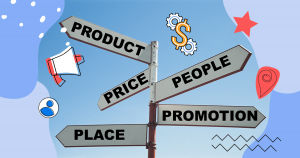Attracting great-quality leads and converting them into happy paying customers are essential parts of running a successful business.
But to do those things right, you’ve got to really know your customers.
You need to fully understand what their pain points and aspirations are, what motivates them to buy something, and what might cause them not to buy something.
Buyer personas and user personas — semi-fictional portraits of your various customer types — can be incredibly helpful in this regard.
However, it’s crucial to understand the difference between user persona vs buyer persona, as they’re not interchangeable terms.
Here’s a breakdown of everything you need to know to succeed with both.
What are Buyer Personas?
Your buyers are the people who actually decide to finalize a purchase, so buyer personas are hypothetical profiles of the singular types of people who buy from you.
Buyer personas are typically designed to feel as much like real example customers as possible. They have ages, genders, ethnic backgrounds, sexual orientations, and locations.
They also have dreams, aspirations, worries, and concerns, just like real people. Think of your buyer personas as social media profiles for your hypothetical customers.
Studying and working with a buyer persona can help a marketer better empathize with the customers that persona represents.
The ultimate goal is to better understand their behavior as consumers and use what you discover to create better, more effective marketing materials and products.
How to Create Buyer Personas
Successful digital marketing strategies never rely on guesses and assumptions, which is just as much the case when creating accurate buyer personas. Here’s a look at how to get it right.
Gather your data
Just as no two companies are alike, neither are any two customer bases.
Get to the bottom of who your customers really are by gathering as much information about them as possible.
Yes, this means compiling data on your paying customers, but good buyer personas also consider your social media audience and website visitors.
You can further ensure your data is extra-thorough by interviewing or surveying members of your target demographics, whether they’ve already connected with you personally or not.
It’s a good idea to consider who your competitors are targeting, as well.
Look for similarities
Analyze your data collectively and look for similarities between the individual examples.
What age, gender, ethnic, and locational demographics do your targets occupy? Where do they work, what is their home life like, and what are their aspirations? What problems might these people have that your products can effectively solve?
Eventually, you’ll see patterns emerge — specific customer groups that share many traits, motivations, and pain points.
Each of these groups should be the basis for a separate buyer persona.
Craft your personas
Every marketing expert has their own opinion on just how much detail you should add to a buyer persona.
Some believe in making personas realistic to the point of giving them names and even profile pictures.
And while this is fine to do if it helps your process, it’s essential to make sure you’re not buying into a common buyer persona myth and creating a bias that may cause you to overlook real people who likely do buy your products.
But you should definitely make your personas feel as authentic as possible, the better to help you relate to your actual existing and potential paying customers.
Keep in mind that personas are more than just lists of details. They’re semi-fictional characters with ages, hobbies, preferences, jobs, and personal goals (financial and otherwise).
What are User Personas?
In contrast to your buyers, your users are the people who ultimately wind up using your products.
In some cases, the user and the buyer are the same person, but not always.
For instance, spouses and domestic partners often shop for one another, and parents often buy things for their children.
In the B2B sector, a department manager may be the person who completes a software purchase (the buyer), while his employees will be using the software (the users).
So one of the biggest things to understand when considering user persona vs buyer persona is the potential difference in needs, wants, and motivations as far as how both customer types interact with the product.
A buyer will naturally be concerned with issues like price point, value, and so forth. But a user will primarily be concerned with whether the product is user-friendly, efficient, and effective.
How to Create User Personas
The process of creating a user persona is very similar to the above process for creating buyer personas, so you can apply the same basic process.
Like buyers, users belong to specific demographics, as well as have unique needs, goals, challenges, and concerns.
And user personas should also resemble real people closely enough to help you understand the actual people they represent.
However, it’s essential to consider the factors that might differentiate a user from a buyer in cases where they’re not the same person.
Looking to research is critical here, so make sure the details you add to your user personas are based on hard facts and real-world data.
User Persona vs Buyer Persona: What are the Differences?
The differences between user persona vs buyer persona boil down to a few key points to keep in mind as you navigate the process of creating and using both. Here’s a closer look at each.
1. They may or may not represent the same people
Again, one of the most common mistakes marketers make when creating hypothetical personas for their customers is failing to understand the difference between buyers and users.
They can be the same people, but they often aren’t, especially within B2B contexts.
Buyer and user personas can even represent entire groups of people (like families or professional teams) in some instances.
2. The customers represented have different goals and concerns
In cases where your buyers and users aren’t one and the same, it’s critical to understand how different their values and concerns will be when it comes to your product.
A user will only care whether the product does what it’s supposed to do and is easy to use.
However, a buyer will be much more concerned with higher-level goals like cost-effectiveness and long-term benefits.
3. Effective user personas are often simpler than buyer personas
Although details are great when it comes to fleshing out your customer personas, it’s crucial to make sure you only include what’s necessary and helpful.
That said, a user persona will generally be on the lean side as far as details. A more straightforward set of needs and objectives means a more streamlined profile.
Meanwhile, buyer personas need to include more information on purchasing behavior to be truly effective.
4. They serve different purposes for marketers
Although your buyers are ultimately the ones who will finalize a sale with you, it’s important to remember that your users are also customers.
They’re ultimately the ones who will be relying on your product to perform as advertised, and in many cases, they may have more say in the final purchase decision than you think — as in cases where consumers are buying for friends, relatives, or loved ones.
That said, the end goal of a buyer persona is to better understand how that person behaves and makes decisions as a consumer.
The objective of a user persona, on the other hand, is to help you empathize with those who use what you produce.
User Persona vs Buyer Persona: How Do They Work Together?
When it comes to your digital marketing campaign, it’s really not a matter of choosing between user persona vs buyer persona.
You need both, and although they’re different, they can work beautifully together with a bit of know-how and creativity.
#1. Content Creation
Your content creation efforts should cater to all of the different people who might want or need information about your products and the issues they’re designed to solve, and your buyer and user personas can both help with that.
For example, you can create informative posts and buying guides for those looking for the right product solution to purchase and user guides, maintenance guides, and product hacks for users.
#2. Product Development
When it comes to creating better, more efficient products that more effectively meet your customers’ needs, you need to consider both buyers and users.
Reviewing the differences between user persona vs buyer persona during initial product development or redesigns can help ensure you don’t overlook the needs and preferences of either group.
#3. Customer Relations
These days, it’s imperative to establish and cultivate personal relationships with those connected to your brand.
To do that, all of the people who use, buy, and consider your products need to feel like you truly know them and understand their needs.
Using both user and buyer personas as jumping-off points for your efforts can help you make sure you’re not leaving anyone out.
Wrap Up: Make Stronger Connections to Customers with Dynamic Content
In the digital age, the connections and relationships you establish with your customers are absolutely everything.
The whole point of understanding user persona vs buyer persona is to get better at putting yourself into your customers’ shoes and meeting their expectations on every level.
Personalization is part of the process of doing this, and learning to generate content experiences that change and shift according to the needs of the consumer on the receiving end can help you smash your marketing goals.
Check out our handy guide on dynamic content for a closer look at the process!
You’ll learn the basics of dynamic content, as well as some go-to techniques for creating experiences that really resonate.









